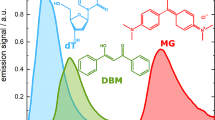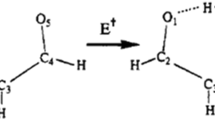Abstract
In the ground state, α-naphthol interacts with water via oxygen, whereas with alcohols (ethanol and isopropanol) and acetonitrile it interacts via hydrogen from the hydroxyl group. In the excited state, α-naphthol interacts much more weakly. An analysis of the dependences of positions of electronic-vibrational transitions on the solvent basicity and acidity demonstrates their nonlinearity. For the parameters describing the solvation ability of the solvent, linear dependences are observed for the following series of solvents: isopropanol, ethanol, acetonitrile, and water. The possible values of the acid number (pA*) for the excited α-naphthol molecule fall within the interval from 0.4 to 1.4 depending on the chosen maximum of the absorption band. In fluorescence spectra, the band intensities differ for neutral and ionic modifications of the molecule. The fluorescence efficiency of the neutral molecule is by an order of magnitude higher than that of the ionic modification. Possible channels of quenching of the ionic modification are discussed.
Similar content being viewed by others
REFERENCES
A. N. Terenin, Photonics of Dye Molecules [in Russian], Nauka, Moscow (1967).
Wan Peter and Shukla Deepak, Chem. Rev., 93, 571–584 (1993).
Encyclopedia of Chemistry [in Russian], Sovetskaya Entsiklopediya, Moscow (1990).
ÒÎmoyuki Yatsuhashi and Haruo Inoue, J. Phys. Chem., A101, 8166–8173 (1997).
K. M. Solntsev, Dan Huppert, and Noam Agmon, J. Phys. Chem., A102, 9599–9606 (1998).
S. P. Webb, L. A. Philips, S. W. Yeh, et al., J. Phys. Chem., 90, 5154–5164 (1986).
P. E. S. Wormer and Ad van der Avoird, Chem. Rev., 100, 4109–4143 (2000).
R. M. Helm, M. Clara, Th. L. Grebner, and H. J. Neusser, J. Phys. Chem., A102, 3268–3272 (1998).
C. Reichardt, Solvents and Solvent Effects in Organic Chemistry, VCH, NY (1988).
Yu. P. Morozova, O. N. Chaikovskaya, and N. Yu. Vasil'eva, Zh. Fiz. Khim., 72, No. 2, 272–276 (1998).
G. O. Bekker, Ed., Introduction to Photochemistry of Organic Compounds [in Russian], Khimiya, Leningrad (1976).
G. V. Mayer and V. I. Danilova, Quantum Chemistry, Structure, and Photonics of Molecules [in Russian], Publishing House of Tomsk State University, Tomsk (1984).
S. Nagakura and M. Gouterman, J. Phys. Chem., 881–885 (1980).
J. Barltrop and J. Coil, Excited States in Organic Chemistry [Russian translation], Mir, Moscow (1978).
J. Lakowich, Fundamentals of Fluorescent Spectroscopy Mir, Moscow (1986).
Author information
Authors and Affiliations
Rights and permissions
About this article
Cite this article
Zharkova, O.M., Korolev, B.V. & Morozova, Y.P. Intermolecular Interactions. Absorption and Fluorescence Spectra of α-Naphthol. Russian Physics Journal 46, 68–74 (2003). https://doi.org/10.1023/A:1024056804352
Issue Date:
DOI: https://doi.org/10.1023/A:1024056804352




